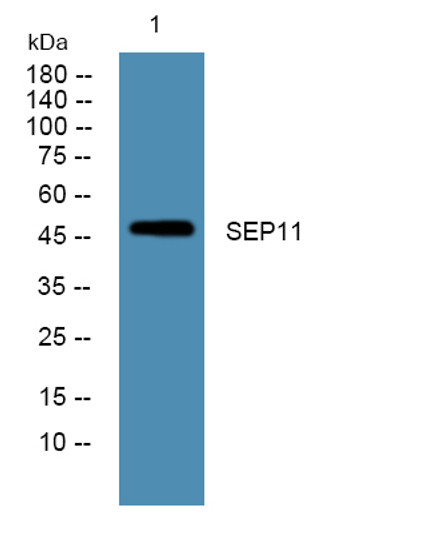| Host: | Rabbit |
| Applications: | WB/ELISA |
| Reactivity: | Human/Mouse/Rat |
| Note: | STRICTLY FOR FURTHER SCIENTIFIC RESEARCH USE ONLY (RUO). MUST NOT TO BE USED IN DIAGNOSTIC OR THERAPEUTIC APPLICATIONS. |
| Short Description : | Rabbit polyclonal antibody anti-Septin-11 (200-280 aa) is suitable for use in Western Blot and ELISA research applications. |
| Clonality : | Polyclonal |
| Conjugation: | Unconjugated |
| Isotype: | IgG |
| Formulation: | Liquid in PBS containing 50% Glycerol and 0.02% Sodium Azide. |
| Purification: | The antibody was affinity-purified from rabbit antiserum by affinity-chromatography using epitope-specific immunogen. |
| Concentration: | 1 mg/mL |
| Dilution Range: | WB 1:500-2000ELISA 1:5000-20000 |
| Storage Instruction: | Store at-20°C for up to 1 year from the date of receipt, and avoid repeat freeze-thaw cycles. |
| Gene Symbol: | SEPTIN11 |
| Gene ID: | 55752 |
| Uniprot ID: | SEP11_HUMAN |
| Immunogen Region: | 200-280 aa |
| Specificity: | SEP11 Polyclonal Antibody detects endogenous levels of protein. |
| Immunogen: | Synthesized peptide derived from the human protein at the amino acid range 200-280 |
| Function | Filament-forming cytoskeletal GTPase. May play a role in cytokinesis (Potential). May play a role in the cytoarchitecture of neurons, including dendritic arborization and dendritic spines, and in GABAergic synaptic connectivity. During Listeria monocytogenes infection, not required for the bacterial entry process, but restricts its efficacy. |
| Protein Name | Septin-11 |
| Cellular Localisation | CytoplasmCytoskeletonSynapseCell ProjectionDendritic SpineAxonPartly Colocalizes With Stress Fibers And MicrotubulesDuring Bacterial InfectionDisplays A Collar Shape Structure Next To Actin At The Pole Of Invading Bacteria |
| Alternative Antibody Names | Anti-Septin-11 antibodyAnti-SEPTIN11 antibodyAnti-SEPT11 antibody |
Information sourced from Uniprot.org









